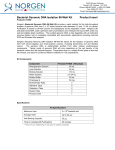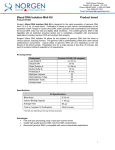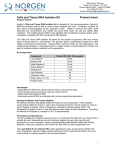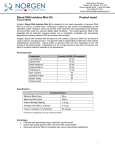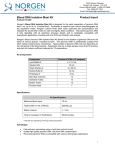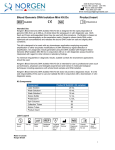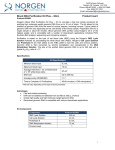Download 46350 - Protocol (2 x 96-well)
Transcript
3430 Schmon Parkway Thorold, ON, Canada L2V 4Y6 Phone: 866-667-4362 (905) 227-8848 Fax: (905) 227-1061 Email: [email protected] Blood DNA Isolation 96-Well Kit Product Insert Product # 46350 Norgen’s Blood DNA Isolation 96-Well Kit provides a rapid method for the high-throughput isolation of genomic DNA from up to 200 L of whole blood. Purification is based on 96-well column chromatography as the separation matrix. Norgen’s 96-well plate binds DNA under optimized salt concentrations and releases the bound DNA under low salt and slightly alkali conditions. The purified genomic DNA is fully digestible with all restriction enzymes tested, and is completely compatible with downstream applications including real-time PCR and Southern Blot analysis. Norgen’s Blood Genomic DNA Isolation 96-Well Kit allows for the isolation of genomic DNA from the blood of various species, including humans. The genomic DNA is preferentially purified from other cellular proteinaceous components. Typical yields of genomic DNA will vary depending on the cell density of the blood sample. Preparation time for a single 96-well plate is less than 90 minutes, and each kit contains sufficient materials for 192 preparations. Kit Components Component Lysis Buffer B Solution WN Wash Solution A Elution Buffer B Proteinase K 96-Well Plate Adhesive Tape 96-Well Collection Plate 96-Well Elution Plate Product Insert Product #46350 (192 preps) 2 x 40 mL 55 mL 2 x 38 mL 2 x 30 mL 4.5 mL 2 4 2 2 1 Specifications Kit Specifications Maximum Blood Input 200 L Average Yield (200 L of blood) 2-8 g* Time to Complete 96 Purifications 45 minutes * Yield will vary depending on the type of blood processed Advantages Fast and easy processing using either a vacuum manifold or centrifugation Isolate high quality genomic DNA Isolate genomic DNA from various species, including humans Recovered genomic DNA without RNA contamination is compatible with various downstream applications Storage Conditions and Product Stability All solutions should be kept tightly sealed and stored at room temperature. These reagents should remain stable for at least 1 year in their unopened containers. The kit contains a ready-touse Proteinase K solution, which is dissolved in a specially prepared storage buffer. The Proteinase K is stable for up to 1 year after delivery when stored at room temperature. To prolong the lifetime of Proteinase K, storage at 2–8°C is recommended. Precautions and Disclaimers This kit is designed for research purposes only. It is not intended for human or diagnostic use. Ensure that a suitable lab coat, disposable gloves and protective goggles are worn when working with chemicals. For more information, please consult the appropriate Material Safety Data Sheets (MSDSs). These are available as convenient PDF files online at www.norgenbiotek.com. The Lysis Buffer B and Solution WN contain guanidinium salts, and should be handled with care. Guanidinium salts form highly reactive compounds when combined with bleach, thus care must be taken to properly dispose of any of these solutions. Blood of all human and animal subjects is considered potentially infectious. All necessary precautions recommended by the appropriate authorities in the country of use should be taken when working with blood. Customer-Supplied Reagents and Equipment You must have the following in order to use the Blood Genomic DNA Isolation 96-Well Kit: 1.5 mL microcentrifuge tubes 96 - 100% ethanol Benchtop microcentrifuge Collection/Waste Tray for vacuum manifold. Two 96-Well Collection Plates are provided with the kit. 56°C waterbath or incubator Vortex Nuclease-free water (for volume adjustment of samples < 200 L) Lysozyme (for blood containing Gram positive bacterial pathogens) º 37 C incubator (for blood containing Gram positive bacterial pathogens) For Vacuum Format: o Vacuum manifold with vacuum pump capable of generating a minimum pressure of -650 mbar or -25 in. Hg (such as Whatman UniVac 3 Vacuum to Collect Manifold) o Sealing tape or pads For Centrifuge Format: o Centrifuge with rotor for 96-well plate assembly, such as AllSpin Js-5.3 Rotor for Avanti® J-26xp centrifuge, Beckman Coulter or similar rotor that can hold the stack of the 96-well Plate and the 96-Well Collection Plate and that can reach the minimum speed of 4000 rpm (~4000xg) Flow Chart Procedure for Purifying Blood DNA using Norgen’s Blood Genomic DNA Isolation 96-Well Kit Add Proteinase K and blood sample to a microcentrifuge tube Add Lysis Buffer B, mix. Incubate for 10 minutes at 55°C. Add ethanol. Mix Bind Wash once with Solution WN Wash twice with Wash Solution A.. Dry plate Elute DNA with Elution Buffer B Pure Blood Genomic DNA Procedure For Vacuum Manifold: All vacuum steps are performed at room temperature. The correct pressure can be calculated using the conversions: 1 mbar = 100 Pa = 0.0394 in. Hg = 0.75 mm Hg = 0.0145 psi For Centrifugation: All centrifugation steps are performed at room temperature. The correct rpm can be calculated using the formula: RPM = RCF (1.118 x 10-5) (r) where RCF = required gravitational acceleration (relative centrifugal force in units of g); r = radius of the rotor in cm; and RPM = the number of revolutions per minute required to achieve the necessary g-force. Notes prior to use: Ensure that all solutions are at room temperature prior to use, and that no precipitates have formed. If necessary, warm the solutions and mix well until the solutions become clear again. The isolation of DNA from whole blood, plasma and serum can be performed using either a vacuum manifold or centrifugation. For purification using vacuum, please follow the procedure outlined in Section 2A. For purification using centrifugation, please follow the procedure outlined in Section 2B. Lysate preparation is the same for both procedures. For best results, the use of whole blood collected into tubes containing an anticoagulant is highly recommended. Both fresh and frozen anticoagulated blood may be used with this procedure. Ensure that frozen blood is thawed at room temperature prior to starting the protocol. The volumes stated in each procedure for lysate preparation are the volumes required to prepare samples for each well of the 96-well plate. Prepare a working concentration of Solution WN by adding 73 mL of 96-100% ethanol (provided by user) to the supplied bottle containing concentrated Solution WN. This will give a final volume of 128 mL. The label on the bottle has a box that can be checked to indicate that ethanol has been added. Prepare a working concentration of Wash Solution A by adding 90 mL of 96 - 100% ethanol (provided by the user) to the supplied bottles containing concentrated Wash Solution A. This will give a final volume of 128 mL. The label on the bottle has a box that can be checked to indicate that ethanol has been added. For blood containing Gram positive bacterial pathogens, prepare a 400 mg/mL stock 7 solution (approximately 1.7 x 10 units/mL) of lysozyme as per supplier's instructions. Always vortex the Proteinase K before use. 1. Lysate Preparation NOTE: For DNA isolation from blood containing Gram positive bacterial pathogens, please see Appendix A for Lysate Preparation. a. b. c. Add 20 L of Proteinase K (vortex before use) to a microcentrifuge tube. Transfer up to 200 L of blood or plasma sample to the tube containing Proteinase K. If the blood input volume is less than 200 µL, add Nuclease-free water to bring the blood volume up to 200 µL. d. e. f. Add 300 L of Lysis Buffer B to the sample and mix well by gentle vortexing for 10 seconds. Briefly spin the tube to collect any drops of liquid from the inside of the lid. o Incubate at 56 C for 10 minutes. Note: If any debris is present in the sample, centrifuge for 2 minutes at 14,000 x g (~14,000 RPM) to precipitate. Transfer the clean supernatant to a microcentrifuge tube prior to Step g. g. h. Add 250 L of 96-100% ethanol and mix by gentle vortexing. Briefly spin the tube to collect any drops of liquid from the inside of the lid. 2. Genomic DNA Isolation Note: The purification of genomic DNA from the lysate prepared in Section 1 could be performed using either a vacuum manifold or centrifugation. For purification using vacuum, please follow the procedure outlined in 2A. For purification using centrifugation, please follow the procedure outlined in 2B A. Genomic DNA isolation Using Vacuum Manifold 1. Binding DNA to 96-Well Plate a. Assemble the 96-Well Plate and the vacuum manifold according to manufacturer’s recommendations. b. Apply the lysate into each well of the 96-Well Plate. Tape the plate or any unused wells using sealing tape or pads (provided by the user) according to the vacuum manifold manufacturer’s recommendations. Apply vacuum for 2 minutes. Note: Depending on the starting material, a small quantity of precipitates may appear in the lysate-ethanol mix. No additional step is required to remove these precipitates prior to application of the mixture to the wells. c. Turn off vacuum and ventilate the manifold. Discard the flowthrough. Reassemble the 96-Well Plate and the vacuum manifold. Note: Ensure that all of the lysate from each well has passed through into the collection/waste tray. If the entire lysate volume has not passed, apply vacuum for an additional 2 minutes. 2. DNA Wash a. Apply 500 L of Solution WN to each well of the 96-Well Plate. Tape the plate or any unused wells using sealing tape or pads (provided by the user) according to the vacuum manifold manufacturer’s recommendations. Apply vacuum for 2 minutes. Note: Ensure the entire wash solution has passed through into the collection/waste tray by inspecting the 96-Well Plate. If the entire wash volume has not passed, apply vacuum for an additional 2 minutes. b. Turn off vacuum and ventilate the manifold. Discard the flowthrough. c. Reassemble the 96-Well Plate and the vacuum manifold. d. Apply 500 L of Wash Solution A to each well of the 96-Well Plate. Tape the plate or any unused wells and apply vacuum for 2 minutes. e. Turn off vacuum and ventilate the manifold. Discard the flowthrough Pat the bottom of the 96-Well Plate gently to remove any residual wash buffer. Reassemble the 96-Well Plate and the vacuum manifold. f. Repeat steps 3d and 3e to wash the plate for a third time. g. Apply vacuum for an additional 5 minutes in order to completely dry the plate. h. Turn off vacuum and ventilate the manifold. 3. DNA Elution a. Replace the collection/waste tray in the vacuum manifold with the provided 96-Well Elution Plate. Complete the vacuum manifold assembly with the 96-Well Plate. b. Add 200 L of Elution Buffer B to each well of the plate. c. Apply vacuum for 3 minutes. Note: A smaller elution volume (down to 50 µL) can be used to obtain a more concentrated sample. For maximum yield, 200 µL elutions should be used. 4. Storage of DNA Use the provided adhesive tape to seal the 96-Well Elution Plate. The purified DNA samples may be stored at –20°C for a few days. It is recommended that samples be placed at –70°C for long term storage. B. Genomic DNA Purification Using Centrifugation Note: To purify genomic DNA using a vacuum manifold please follow Section A above. 1. Binding DNA to 96-Well Plate a. Place the 96-Well Plate on top of the 96-Well Collection Plate. Note: The user should ensure that the assembled 96-Well Plate and the 96-Well Collection Plate stack fits into the rotor without interfering with the centrifugation process. b. Apply the lysate into each well of the 96-Well Plate. Centrifuge the assembly at 5,000 RPM (or a minimum of 4,000 RPM) for 4 minutes. c. Discard the flowthrough. Reassemble the 96-Well Plate and the 96-Well Collection Plate. Note: Ensure that all of the lysate from each well has passed through into the 96-Well Collection Plate. If the entire lysate volume has not passed, centrifuge for an additional 2 minutes. 2. DNA Wash a. Apply 500 L of Solution WN to each well of the 96-Well Plate. Centrifuge the assembly at 5,000 RPM (or a minimum of 4,000 RPM) for 2 minutes. Note: Ensure the entire wash solution has passed through into the 96-Well Collection Plate by inspecting the 96-Well Plate. If the entire wash volume has not passed, centrifuge for an additional 2 minutes. b. c. d. e. f. g. Discard the flowthrough. Reassemble the 96-Well Plate and the 96-Well Collection Plate. Apply 500 L of Wash Solution A to each well of the 96-Well Plate. Centrifuge the assembly at 5,000 RPM (or a minimum of 4,000 RPM) for 2 minutes. Discard the flowthrough. Reassemble the 96-Well Plate and the 96-Well Collection Plate. Repeat steps 3c and 3d to wash the 96-Well plate for a third time. Discard the flowthrough. Pat the bottom of the 96-Well Plate dry. Reassemble the 96Well Plate and the 96-Well Collection Plate. Centrifuge the assembly at 5,000 RPM (or a minimum of 4,000 RPM) for 15 minutes in order to completely dry the 96-Well plate. 3. DNA Elution a. Stack the 96-Well Plate on top of the 96-Well Elution Plate. b. Add 200 L of Elution Buffer B to each well of the 96-Well Plate. c. Centrifuge the assembly at 5,000 RPM (or a minimum of 4,000 RPM) for 3 minutes. Note: A smaller elution volume (down to 50 µL) can be used to obtain a more concentrated sample. For maximum yield, 200 µL elutions should be used. 4. Storage of DNA Use the provided adhesive tape to seal the 96-Well Elution Plate. The purified DNA samples may be stored at –20°C for a few days. It is recommended that samples be placed at –70°C for long term storage. Appendix A Notes prior to use: 7 Prepare a 400 mg/mL stock solution (approximately 1.7 x 10 units/mL) of lysozyme as per supplier's instructions. Sample Preparation for Blood Containing Gram Positive Bacterial Pathogens a. Add 20 L of Lysozyme to a microcentrifuge tube, and transfer up to 200 L of blood sample to the tube containing Lysozyme º b. Mix well by vortexing, and incubate at 37 C for 1 hour. (Note: 0.5 to 2 hours incubation time can be used depending on the bacterial strain being lysed). c. After incubation, add 20 L of Proteinase K (vortex before use) to the tube and proceed to Step 1c of Lysate Preparation. Troubleshooting Guide Problem Possible Cause Cell debris may be clogging the 96-Well Plate When a high cell number is expected in the blood sample, ensure that the optional spin for 2 minutes at 14,000 rpm after the Proteinase K incubation is performed. The sample is too large Too many cells were applied to the well. Ensure that Proteinase K and Lysis Buffer B are proportionally added as the blood volume is increased. Clogging can be alleviated by centrifuging for a longer period of time until the lysate passes through the well. Insufficient Vacuum Ensure that a vacuum pressure of at least -650 mbar or -25 in. Hg is developed Centrifuge temperature too low Ensure that the centrifuge remains at room temperature throughout the procedure. Temperatures below 15°C may cause precipitates to form that can cause the wells to clog. Inefficient cell lysis Ensure that correct volume of Lysis Buffer B was added to blood sample. Also increase incubation time up to 15 minutes at 56ºC. Low DNA binding Ensure ethanol is added to the sample. DNA was not washed three times with the provided Solution WN and Wash Solution A Ensure the 96-Well Plate was washed one time with Solution WN and two times with Wash Solution A. An additional wash with Wash Solution A can improve DNA performance in downstream applications, however it may reduce DNA yield. Ethanol carryover Ensure that the dry spin under the Wash procedure is performed, in order to remove traces of ethanol prior to elution. Ethanol is known to interfere with many downstream applications. The 96 well Plate is clogged. The yield of genomic DNA is low DNA does not perform well in downstream applications. Solution and Explanation Related Products Product # Blood DNA Isolation Micro Kit 52100 Blood DNA Isolation Mini Kit 46300 Blood DNA Isolation Midi Kit 51400 Blood DNA Isolation Maxi Kit 31200 Dried Blood Spot Genomic DNA Isolation Kit 36000 HighRanger 1kb DNA Ladder 11900 UltraRanger 1kb DNA Ladder 12100 Technical Support Contact our Technical Support Team between the hours of 8:30 and 5:30 (Eastern Standard Time) at (905) 227-8848 or Toll Free at 1-866-667-4362. Technical support can also be obtained from our website (www.norgenbiotek.com) or through email at [email protected]. 3430 Schmon Parkway, Thorold, ON Canada L2V 4Y6 Phone: (905) 227-8848 Fax: (905) 227-1061 Toll Free in North America: 1-866-667-4362 © 2014 Norgen Biotek Corp. PI46350-3-M14









